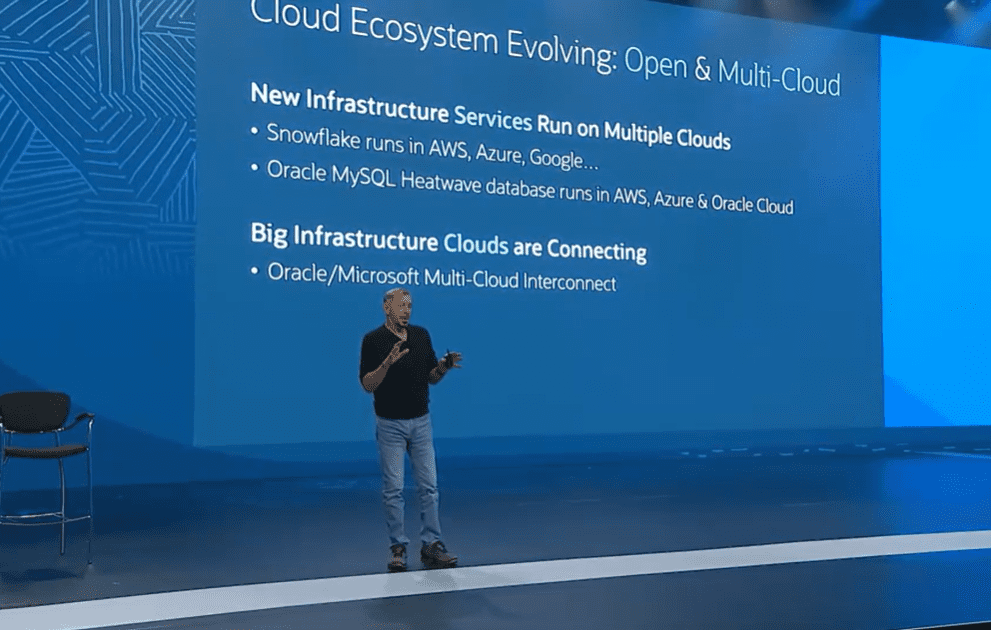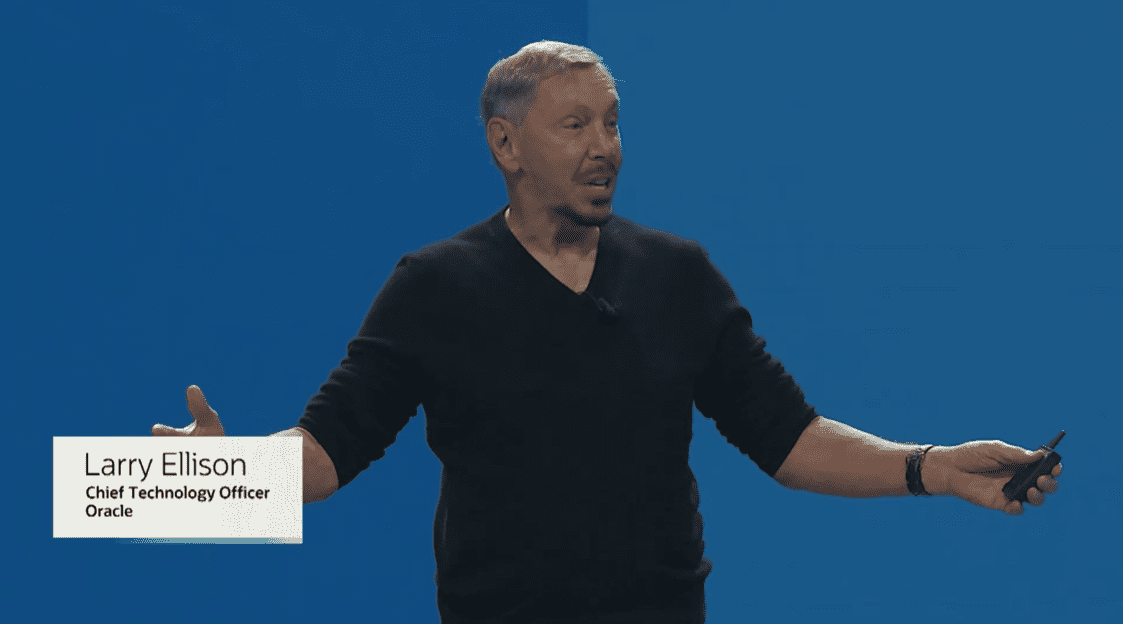In all ranks of Oracle, the company’s ambition within healthcare is noticeable. Both in breadth and depth, Oracle wants to make and continue to make (big) strides.
During Oracle CloudWorld (the new name of OpenWorld, Oracle’s annual flagship event), we sat down as usual for founder and CTO Larry Ellison’s session. His sessions are always guaranteed to deliver. That is, he always says things you can use as an analyst or journalist. AWS in particular is often bashed when he talks about how well a specific Oracle product or service is performing. Some of those claims seem to make sense, others not so much. Either way, Ellison always gives you something to write about.
This time, however, was different. We noted one subtle stab in the direction of AWS, that was it. This did not mean, however, that the session wasn’t interesting. On the contrary, we gained quite a few new insights from it. Insights into Oracle’s overall strategy on a technical level, but certainly also when it comes to how the company wants to differentiate itself.
Much attention to healthcare
Of the little over an hour and a half in which Ellison spoke, only a good 15 minutes was about the “usual” topics. Think of things like making HeatWave available on AWS and the Database Service for Azure. He also stated that the way Oracle and Microsoft are linked together through the Interconnect will be the future for all public clouds.

Ellison spent the remaining 60 minutes of his keynote on another topic, healthcare. In fact, Oracle wants to be and remain one of the driving forces behind the digitization of healthcare. Ellison seized the opportunity to exude thought leadership in this market segment. In itself, this was to be expected, after the more than 25 billion euros the company spent to acquire Cerner. These are not investments you make unless you have a bigger plan for them.
Incidentally, Oracle is not the only (cloud) player that seems to be paying a lot of attention to healthcare. For example, AWS acquired One Medical earlier this year and Google recently introduced its Medical Imaging Suite and partnered with software vendor Epic, one of the larger healthcare IT players. Microsoft is not sitting still on this front either, announcing Azure Health Data Services earlier this year. These are just some of the initiatives. There’s a lot more going on. A quick Google search for any of the four vendors mentioned above gives many relevant hits.
It should be clear by now that healthcare is getting a lot of attention from cloud players. In itself, this is not so surprising, as this industry is not really at the forefront when it comes to digitization and IT innovation. This reminds us of a conversation we had with an MSSP after the first Covid lockdown in 2020 about the impact the lockdown had on the hospitals this service provider served. One thing that came out of that discussion was that, generally speaking, hospitals weren’t using the cloud at all. Nothing had ever been done. It just wasn’t on anyone’s mind.
It’s all about data
From Oracle’s perspective (and actually the other vendors as well), a lot of the challenges in healthcare are about unlocking data. Health data is obviously a hot topic, as it is very personal and often not something you like to share with others. The recent pandemic has shown that it is important to have access to data, to carry out analyses. However, most data is very fragmented. That is, healthcare organizations store it in many different places and links between those locations are rare. It’s a pretty fragmented picture.
The big question is how to better unlock data within healthcare, without risking things happening to that data that are undesirable. That, among other things, is what Oracle wants to solve, according to Ellison. As befits Oracle, and Ellison in particular, he aims high. His plan is to build systems (together with Cerner) that will make it possible to do analysis on data at both the national (U.S.) and global levels.
Ellison, by the way, fully realizes that the above is a very ambitious plan. Still, he is convinced that Oracle can and will deliver. Partly because of its own technology, of course. This is where things like the Autonomous Database and APEX low-code development come into play. Especially the built-in security Oracle prides itself on in OCI gets special mention here. However, he also points out that Oracle cannot do it alone. Merging the expertise of Cerner and Oracle has been a good step, but Oracle also needs an extensive partner network to achieve its ambition. This network consists of universities, university hospitals, but also specialists in areas such as AI.
Oracle means business
To show that Oracle means business, Ellison cites some examples of what Oracle has achieved together with partners during the pandemic. For example, it took no more than 68 days to build an application/information system for the CDC around corona vaccines. Oracle also built GPAS for and together with the University of Oxford in no more than three months. GPAS stands for Global Pathogen Analysis System. It is the first of its kind, according to the University of Oxford. It standardizes disease analysis, starting with Covid. The intention is to further expand its use to other diseases.
Ellison’s plan towards the future is to create databases for EHRs. This will first be for the U.S., but the ambition is to start doing this for any country that wants to do the same. Crucial to the success of Oracle’s ambition is that all data is and remains completely private. That means the encryption keys for the data must reside with the patient. Furthermore, it must also become possible within this database to provide insight into the number of hospital beds per region.
Realizing this ambition, by the way, will not be a matter of months, but rather years. Oracle will also have to discuss this with governments of countries namely. Oracle can basically only make hard promises regarding the technical part of the equation. That part should be up and running in the next year.
Finally, Ellison also points to the ambition to get patients more involved. After all, that also provides valuable additional data. Here he points to v-safe, which Oracle built for the CDC in the US. Through this application, Covid patients could voluntarily report side effects of corona vaccines, among other things.

Going deeper
In addition to the overarching vision for the future from Ellison, there are already more concrete issues in the area of healthcare that are playing out right now. This sector is also currently the focus when it comes to specific vertical focus. We recently published an article about updates focused on healthcare to specific SaaS services within the Fusion Cloud portfolio. These updates have to do with optimzing planning schedules, but also gain more insights into processes inside healthcare institutions. This makes it easier to focus on the mental health of hospital staff. The pandemic has shown that staff went through some very rough times in that respect.
In addition, Oracle also focuses on what it calls vertical applications aimed at specific industries. These link together existing components (like ERP, HCM, EPM, and so on) that customers use in their environments. Within healthcare, you can think of linking the supply chain to clinical systems. For example, you then get very quick answers to the question of where specific medication is. The vertical application – running on OCI – can tell you that right away, Mike Sicilia points out. Sicilia is EVP at Oracle and is responsible for the so-called Global Business Units (GBUs), all of which are verticalized. Healthcare is one of them, totaling eight.
Basically, this vertical approach revolves around the vertical application covering all the relevant components, so to speak. Exactly what those components are is not that relevant from a technical perspective, Sicilia points out. It is fundamentally an open approach, which also fits the modern and future open cloud world we briefly discussed above. Of course, Oracle would prefer that customers purchase as much as possible from Oracle, because the company also offers almost all the relevant components. They can provide almost anything, be it ERP, HCM, CRM or Procurement, to name a few. This will also make it as easy as possible for Oracle to outline the ideal scenario across all components of an organization’s environment.
However, should an organization already use other components that also want to continue using them, you might as well get started with Oracle’s vertical applications. Oracle uses public APIs to link components together, Sicilia points out. That means that basically anything that can be integrated by means of an API is suitable. Sicilia himself calls this a game changer, because it means they can now discuss the entire end-to-end process with customers. For customers, it means they have a fully working vertical application. Thanks to multi-master replication, you can also work with the data from all components. That ensures that you can all work with the same data.
It’s good at this point to emphasize again that these vertical applications that Oracle builds are SaaS solutions. They run on OCI and Oracle manages and maintains them. As Sicilia puts it in conversation with us, “We deliver the car, not the kit that allows you to build the car.”
Impact of Alloy
The outline of vertical applications above is still rather conceptual. That’s why we would like to end with Oracle Alloy, a very concrete announcement at CloudWorld. Oracle Alloy will have a big impact on Oracle’s ambitions in this are as well, we believe. We already wrote an article about this announcement, but want to touch on it again here. In our opinion, the introduction of Alloy plays an important role in Oracle’s approach.
We cited earlier that health data is not something that organizations – and probably patients themselves – are happy to just hand over. Storing this data in the cloud may and will raise some eyebrows. Of course, Oracle has some work to do in this area, Sicilia says when asked how they intend to win people’s hearts and minds.
Above all, he emphasizes that sharing data in the cloud is more secure than on paper. In addition, according to him, we should also look at what patients can gain from it. They should be able to get faster and better feedback based on the data related to their condition. Think of tips on treatment methods, for example. That way, patients will have a relationship with healthcare providers similar to the one they have with retailers, he points out. We doubt this is the right analogy for everyone, but it serves its purpose. Patients should be able to get more out of their health data as well.
Alloy can help Oracle massively in its ambitions, we think. As Oracle Alloy enables partners to offer a public cloud to its customers based on OCI, but completely as their own offering, customers are not storing data in the conventional public cloud. That is, partners can create a new type of sovereign cloud. Data sovereignty and sovereign clouds are a crucial part of the healthcare story as it relates to the cloud. Without it, any attempt to get healthcare institutions to go to the cloud in a convincing fashion will fail.
Alternatively, customers can also choose an Oracle-branded sovereign cloud, when this new offering becomes available in 2023. However, as healthcare is a market with highly specialized needs and demands, and therefore also specialized partners, the Alloy-version of a sovereign cloud could make more sense for healthcare institutions. These partners can offer the full spectrum of services and features from OCI, plus their own sauce on top.
Conclusion
Oracle doesn’t lack in ambition when it comes to healthcare, that much is clear. This is immediately clear from the relatively minor upgrades in existing SaaS applications in the Fusion Cloud Apps portfolio. On top of that, there’s the already considerably more substantial GBU project around the specialized vertical application for healthcare. Even more ambitious are the plans around shaking up the healthcare market as a whole, with the plans Ellison unfolded during his keynote at CloudWorld.
Taken together these various approaches to the healthcare market from Oracle, a lot of the technology seems to be there to achieve the goals the company has. However, it will be quite a job to forge the deep partnerships with partners and governments needed to actually realize them. Oracle simply does not control everything. However, it is clear that Ellison and Oracle mean business. Usually that also means that everything will be done and there will be no stopping until success is achieved.
